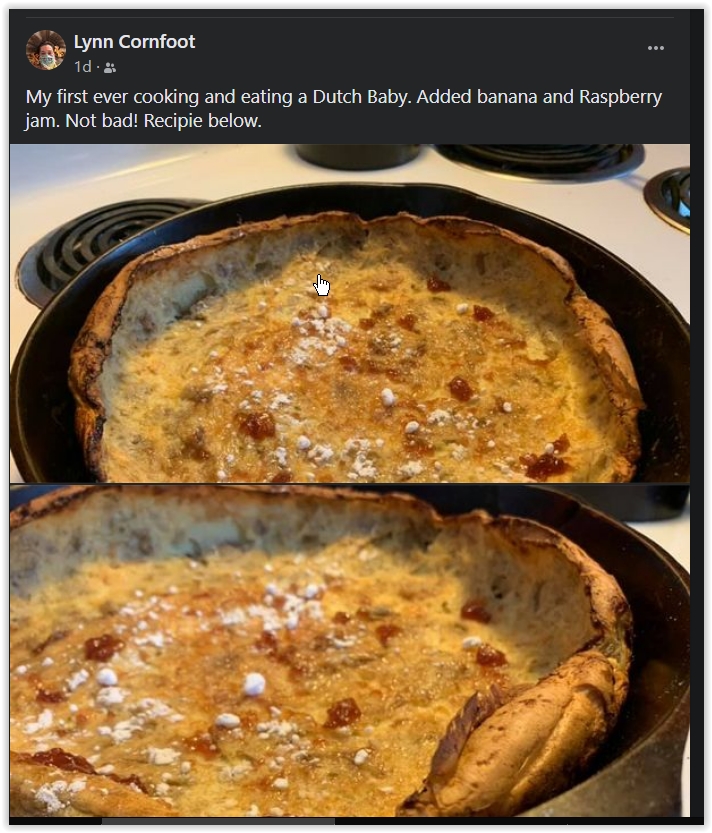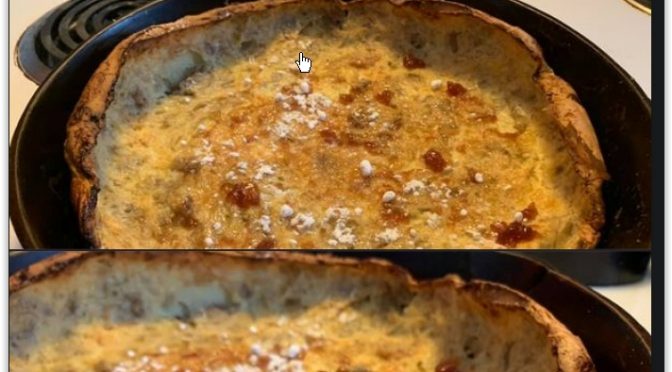A Dutch baby pancake, sometimes called a German pancake, a Bismarck, a Dutch puff, or a Hootenanny, is a large American popover. A Dutch baby is similar to a large Yorkshire pudding.
My Friend Lynn Made the one in photo above it looked so good i made a page about them!
3 tablespoons butter
3 eggs
3/4 cup all-purpose flour
3/4 cup milk, heated 20 to 30 seconds in the microwave
1 tablespoon sugar
2 teaspoons pure vanilla extract
Pinch salt
Confectioners’ sugar, for dusting
-Preheat the oven to 400 degrees F.
-Put the butter in a large, ovenproof, nonstick saute pan and place in the oven.
-Meanwhile, in a blender, combine the eggs, flour, warm milk, sugar, vanilla extract and pinch of salt, and blend on medium-high speed until uniform. (If mixing by hand, combine the eggs with the milk until the mixture is light yellow and no longer stringy, about 1 minute. Add the flour, sugar, vanilla, and pinch of salt, and whisk vigorously to remove the lumps, about 30 seconds.)
-Carefully remove the hot pan from the oven. The butter should be melted. Swirl the butter around the pan to coat completely, and then pour the remaining butter into the batter and pulse to blend. Pour the batter into the hot pan and return the pan to the oven. Cook until the pancake is puffed in the center and golden brown along the edges, 20 to 25 minutes.
-Using a spatula, remove the entire Dutch baby from the pan and place on a cooling rack for a few minutes to allow the steam to escape without condensing along the bottom and rendering the pancake soggy. -Dust with confectioners’ sugar when cooled slightly. Slice the pancake into 8 wedges on a serving platter or cutting board.

My Friend Lynn used https://cooking.nytimes.com/recipes/6648-dutch-baby as her recipe
The idea of a Dutch baby pancake may have been derived from the German Pfannkuchen, but the current form originated in the US in the early 1900s.
According to Sunset magazine, Dutch babies were introduced in the first half of the 1900s at Manca’s Cafe, a family-run restaurant that was located in Seattle, Washington and that was owned by Victor Manca. While these pancakes are derived from the German pancake dish, it is said that the name Dutch baby was coined by one of Victor Manca’s daughters, where “Dutch” perhaps was her corruption of the German autonym deutsch. Manca’s Cafe claimed that it owned the trademark for Dutch babies in 1942.
David Eyre’s pancake is a variation on the Dutch baby pancake named after the American writer and editor David W. Eyre (1912–2008). The recipe was published by The New York Times Food Editor Craig Claiborne in an April 10, 1966, Times article entitled “Pancake Nonpareil”; in addition to generally regularizing quantities and temperatures for modern use, it omitted sugar and salt from the batter. In it, Claiborne recounted discovering the dish at a breakfast prepared by Eyre, then the editor of Honolulu Magazine, while Claiborne was visiting Eyre’s Honolulu home.
Eyre’s version of the pancake was based on a recipe for Dutch baby pancakes from Victor Hirtzler’s Hotel St. Francis Cookbook best known 1919 edition, with slight alteration.
The recipe also appears in The Essential New York Times Cookbook, whose author, longtime food writer Amanda Hesser, counts it among her favorites. She names it as one of the top five recipes recommended to her for inclusion when she set out to write the book.
A Dutch baby is very similar to a Yorkshire pudding, with a few differences: the Yorkshire pudding is more likely to be baked in individual servings, the pan is usually greased with beef drippings, and the result is rarely sweet.Dutch babies are larger, use butter rather than beef fat, and are frequently sweet. They use more eggs than a Yorkshire pudding and normally have sugar and vanilla and, unlike a Yorkshire pudding, are normally cooked in a cast iron frying pan.
